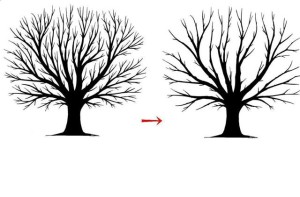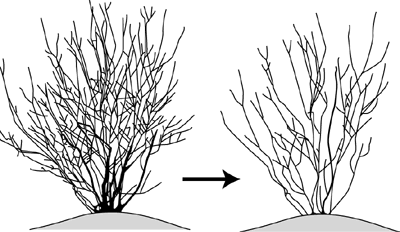Pruning in the Dormant Season
©2013-2014 Danylo Kosovych and Organic Edible Gardens LLC
What most people consider pruning is taking a power tool to the exterior of a shrub and turning it into a perfect ball, or hedge row. While this tactic applies to hedges it does not benefit most shrubs and trees. A common pruning practice that you will see when it comes to trees is chopping off the top of crape myrtles. The crape myrtle will survive and flower a lot the next year but the aesthetic structure of the tree is lost forever and will have to be pruned in the same manner every year thereafter.
A much more practical way of pruning which enhances the aesthetic structure of the tree while aiding in pest and disease resistance and increases fruiting (in fruit trees), is pruning from the inside out. This process is called thinning.
The primary objective of thinning is structural; open up the canopy for air and light penetration. Allowing more air to flow in the center of a tree or shrub canopy reduces disease by allowing limbs and leaves to dry sooner. Increasing sunlight onto the interior buds of a tree increases fruit production. Shaded branches are unproductive but they still use nutritional resources.
During the winter, woody plants store their energy in their trunks and roots. Branches have little stored energy and can be removed without altering the stored energy of the tree or shrub. Because of their dormant state large portions of trees and shrubs can be removed. Plants heal best in the spring and summer, when their physiological processes are at their peak. Wounds from fresh cuts are prone to winter injury, therefore late winter is best. Plants can also be pruned in the summer but major limb removal should be kept to a minimum because you will be reducing the energy of the plant. If the plant is spring flowering and the pruning needs minimal you can wait until after flowering.
The best way to prune a tree or shrub is by looking at the plant from the inside out. Before you cut anything, analyze the plant. Find the large branches that reach the canopy. They should come out of the trunk at an almost perpendicular angle. These are the main structural branches. Do not remove these. Start by removing dead, diseased or broken branches. Any small branch that starts within the interior and does not make it to the canopy can be removed. They are shaded and unproductive. Remove any branches that come out of the truck with a very small crotch angle and then grow vertically through the canopy. They are shoots. They will be of smaller size than the main structural branches and entangled through the entire canopy. When making a cut it is best to remove an entire branch from the trunk at the end of the branch collar.
The resulting tree or shrub will have a cleaner look. There will be less small limbs in the interior of the canopy making the larger structural branches more visible. It will also be more resilient and require less ongoing maintenance as plants pruned from the top down.


